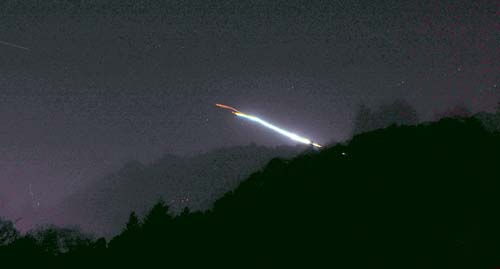Spectacular Meteor Sparks Fireball Over California

Update: See our latest observing guide and preview for the weekend Orionid meteor shower here:Orionid Meteor Shower Peaks Tonight: How to Watch Online
A spectacular meteor lit up the sky over California Wednesday night (Oct. 17) just days before a highly anticipated meteor shower hits its peak this weekend.
The meteor put on a dazzling display over Northern California when it streaked across the sky at 7:44 p.m. PDT (0244 GMT), according to scientists at NASA's Ames Research Center in Moffett Field. The subsequent fireball and sonic boom triggered a flood of reports by witnesses to local news stations and authorities, with accounts coming in from across San Francisco and the Bay Area, according to ABC's KGO-TV news station.
"At 7:44:44 pm PDT this evening, a bright fireball was seen in the San Francisco Bay Area," scientists with Ames' Cameras for Allsky Meteor Surveillance (CAMS) wrote in an update. The project is led by meteor expert Peter Jenniskens of the SETI (Search for Extraterrestrial Intelligence) Institute. "We are checking our CAMS camera results to see if we have a track. Biggest question at the moment is whether this ended over land or ocean."
The celestial fireworks came just days ahead of this weekend's Orionid meteor shower peak, which occurs overnight on Oct. 20 and 21. The meteor shower is created by bits of the famed Halley's Comet as they hit Earth's atmosphere and flare up in fiery display.
NASA meteor expert Bill Cooke at the agency's Marshall Space Flight Center in Huntsville, Ala., has said the 2012 Orionid meteor shower should create dozens of meteors an hour, weather permitting. Because the moon is just a few days past its dark, "new" phase, it won't interfere with the weekend "shooting stars" show.
The Orionid meteor shower is one of two meteor displays created by Halley's Comet, which makes one orbit around the sun every 76 years. The other is the Eta Aquarid meteor shower, which occurs in May. The two meteor showers are created when the Earth passes through streams of dust cast off from Halley's Comet.
Breaking space news, the latest updates on rocket launches, skywatching events and more!
Editor's Note: If you snapped a photo of Wednesday night's dazzling meteor and would like to share it with SPACE.com, please send images, comments and your location info to managing Editor Tariq Malik at: tmalik@space.com.
You can follow SPACE.com Managing Editor Tariq Malik on Twitter @tariqjmalik and SPACE.com on Twitter @Spacedotcom. We're also on Facebook & Google+.

Tariq is the award-winning Editor-in-Chief of Space.com and joined the team in 2001. He covers human spaceflight, as well as skywatching and entertainment. He became Space.com's Editor-in-Chief in 2019. Before joining Space.com, Tariq was a staff reporter for The Los Angeles Times covering education and city beats in La Habra, Fullerton and Huntington Beach. He's a recipient of the 2022 Harry Kolcum Award for excellence in space reporting and the 2025 Space Pioneer Award from the National Space Society. He is an Eagle Scout and Space Camp alum with journalism degrees from the USC and NYU. You can find Tariq at Space.com and as the co-host to the This Week In Space podcast on the TWiT network. To see his latest project, you can follow Tariq on Twitter @tariqjmalik.


